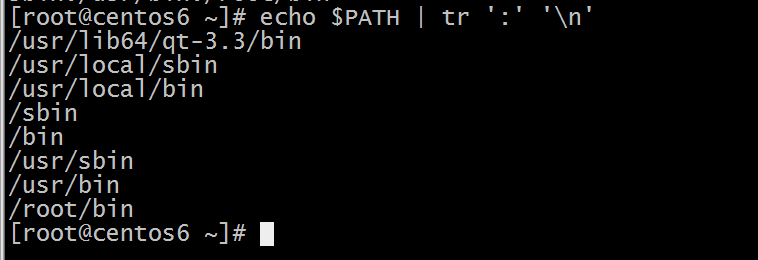Linux初體驗之練習篇(七)
tr
IO重定向
神奇的自動掛載
tr
主要用途
轉換或刪除字符
tr - translate or delete characters tr [OPTION]... SET1 [SET2]
tr命令是一個強大的字符轉換工具,可以對來自標準輸入的字符進行各種轉換,包括字符集對應轉換、刪除或都取字符補集、壓縮和格式調整。格式調整包括換行、回車、加入製表符等。
常用參數
-c, -C: --complemen, 取字符集的補集
-d: --delete, 刪除所有屬於第一個字符集的字符
-s: --squeeze-repeats, 壓縮連續重複的字符爲單獨的一個字符
-t: --truncate-set1, 將第一個字符集對應的字符轉換爲第二個字符集對應的字符
tr對字符的格式調整
\\ backslash \a audible BEL \b backspace \f form feed # 換頁 \n new line \r return \t horizontal tab \v vertical tab
tr可用的字符集:
使用格式:tr '[:lower:]' '[:upper:]' [:alnum:]:字母和數字 [:alpha:]:字母 [:cntrl:]:控制(非打印)字符 [:digit:]:數字 [:graph:]:圖形字符 [:lower:]:小寫字母 [:print:]:可打印字符 [:punct:]:標點符號 [:space:]:空白字符 [:upper:]:大寫字母 [:xdigit:]:十六進制字符
使用示例見末尾的練習
IO重定向
我們都知道,所謂程序,可簡單表示爲:程序=指令+數據,而在Linux系統中,數據流可分爲三大類:
標準輸入:standard input ——0 默認接受來自鍵盤的輸入 標準輸出:standard output ——1 默認輸出到終端窗口 標準錯誤輸出:standard error ——2 默認輸出到終端窗口
所以,IO重定向就是改變IO輸入輸出的默認位置!而IO重定向的方式就要有 重定向符號與管道 兩種方式。
另外,在Linux中,每個文件都有一個文件描述符 fd (file descriptor), 而這些文件描述符fd都會關聯到一個設備上,Linux就是就是通過這些文件描述符來訪問文件的!
查看文件描述符fd:
[root@centos6 ~]# cd /proc
1. 輸出重定向操作符
格式:命令 操作符 文件名 > 把STDOUT重定向到文件,文件內容會被覆蓋 2> 把STDERR重定向到文件 &> 把所有輸出重定向到文件 >> 原有內容基礎上,追加內容 >| 強制覆蓋2>: 覆蓋重定向錯誤輸出數據流 2>>: 追加重定向錯誤輸出數據流 合併標準輸出和錯誤輸出爲同一個數據流進行重定向: &>:覆蓋重定向 &>>:追加重定向 COMMAND > /path/to/file.out 2>&1 (順序很重要) COMMAND >> /path/to/file.out 2>>&1 ():多條命令輸出重定向 (cal2007;cal2008) > all.txt 標準輸出和錯誤輸出各自定向至不同位置: COMMAND > /path/to/file.out 2> /path/to/error.out
注:爲避免文件被誤覆蓋:有以下兩個功能選項
# set -C: 禁止覆蓋,但可追加 # set +C: 允許覆蓋
2. 輸入重定向操作符
格式:命令 操作符 文件名 命令 操作符 終止詞 < 重定向標準輸入 <<終止詞 多行輸入重定向
3. 管道
在linux系統中,管道的主要功能是將其他程序的輸出結果直接導出到另一程序, 來做輸入數據,即將前一程序的輸出作爲後一個程序的輸入,符號爲"|"。 管道的語法格式爲: COMMAND1 | COMMAND2 | COMMAND3 ... 將標準錯誤輸出一起輸入管道,命令格式爲: COMMAND1 |& COMMAND2 |& COMMAND3 ...
4. tee: 重定向到多個目標
tee
主要用途
重定向數據到文件且保存一個副本作爲後續命令的輸入
tee - read from standard input and write to standard output and files tee [OPTION]... [FILE]...
tee命令作爲重定向數據的一個得力工具,其最大的特點是能夠“分流”數據,一邊可以重定向數據到目標文件,一邊可以將重定向的數據保存一個副本作爲後續命令的標準輸入。一句話,就是把數據重定向到目標文件並輸出到屏幕。
常用參數
-a: --append,重定向時追加而不覆蓋
-i: --ignore-interrupts, 忽略中斷信號
使用示例
[root@centos6 ~]# ls | tee /testdir/ls.log anaconda-ks.cfg Desktop Documents Downloads install.log install.log.syslog Music Pictures Public Templates Videos [root@centos6 ~]# cat /testdir/ls.log anaconda-ks.cfg Desktop Documents Downloads install.log install.log.syslog Music Pictures Public Templates Videos [root@centos6 ~]#
[root@centos6 ~]# ls | tee out.txt | cat -n 1 anaconda-ks.cfg 2 Desktop 3 Documents 4 Downloads 5 install.log 6 install.log.syslog 7 Music 8 Pictures 9 Public 10 Templates 11 Videos [root@centos6 ~]# cat out.txt anaconda-ks.cfg Desktop Documents Downloads install.log install.log.syslog Music Pictures Public Templates Videos [root@centos6 ~]#
神奇的自動掛載
在centos 6下有個神奇的自動掛載文件:misc
[root@centos6 ~]# rpm -i /misc/cd/Packages/SOFTNAME
雖然df命令查不出其痕跡:
[root@centos6 ~]# dfFilesystem 1K-blocks Used Available Use% Mounted on /dev/sda2 100660656 4614984 90925672 5% / tmpfs 953648 224 953424 1% /dev/shm /dev/sda1 194241 39141 144860 22% /boot /dev/sda3 20027260 333820 18669440 2% /testdir /dev/sr0 3824484 3824484 0 100% /media/CentOS_6.8_Final
神奇的是可直接使用 # rpm -i /misc/cd/Packages/SOFTNAME 直接掛載。
練習一
1、使用別名命令,每日將/etc/目錄下所有文件,備份到/testdir/下獨立的新目錄下,並要求新目錄格式爲backupYYYY-mm-dd ,備份過程可見。
2、先創建/testdir/rootdir目錄,再複製/root所有下文件到該目錄內,並要求保留原有權限。
1、 [root@centos6 testdir]# alias backup='cp -rv /etc/ /testdir/backup`date +%F`'
2、 [root@centos6 ~]# cp -r --preserv=mode /root/ /testdir/rootdir
練習二
1、將/etc/issue文件中的內容轉換爲大寫後保存至/tmp/issue.out文件中
[root@centos6 ~]# tr 'a-z' 'A-Z' < /etc/issue >/tmp/issue.out
2、將當前系統登錄用戶的信息轉換爲大寫後保存至/tmp/who.out文件中
[root@centos6 ~]# w | tr 'a-z' 'A-Z' > /tmp/who.out
3、一個linux用戶給root發郵件,要求郵件標題爲”help”,郵件正文如下: Hello, I am 用戶名,the system version is here,pleasehelp me to check it ,thanks! 操作系統版本信息
[liansir@centos6 ~]$ echo -e "Hello, I am $(whoami), the system version is here, please help me to check it, thanks! \n$(lsb_release -a)" | mail -s help root [liansir@centos6 ~]$
4、將/root/下文件列表,顯示成一行,並文件名之間用空格隔開。
[root@centos6 ~]# ls -x file1 file10 file2 file3 file4 file5 file6 file7 file8 file9 [root@centos6 ~]# ls --format=horizontal file1 file10 file2 file3 file4 file5 file6 file7 file8 file9 或: [root@centos6 ~]# [root@centos6 ~]# ls -a | tr '\n' ' '
5、file1文件的內容爲:”1 2 3 4 5 6 7 8 9 10” 計算出所有數字的總和
[root@centos6 ~]# echo "1 2 3 4 5 6 7 8 9 10" | tr ' ' + | bc 55 [root@centos6 ~]# 或 [root@centos6 ~]# echo $[`echo "1 2 3 4 5 6 7 8 9 10" | tr ' ' + `] 55 [root@centos6 ~]# 或 [root@centos6 ~]# echo "1 2 3 4 5 6 7 8 9 10" > file2 [root@centos6 ~]# tr ' ' + < file2 | bc 55 [root@centos6 ~]# 或 [root@centos6 ~]# cat file3 1 2 3 4 5 6 7 8 9 10 # 以下兩種方法應該要優於上面的,假如一個文件中有1....10000的數的話。。。。 [root@centos6 ~]# tr " " "+" < file3 | bc 55 [root@centos6 ~]# tr ' ' + < file3 | bc 55 [root@centos6 ~]#
6、刪除Windows文本文件中的'^M'字符
[root@centos6 ~]# tr -d '\r' < win.txt > win2.txt
7、處理字符串“xt.,l 1 jr#!$mn2 c*/fe3 uz4”,只保留其中的數字和空格
[root@centos6 ~]# echo 'xt.,l 1 jr#!$mn2 c*/fe3 uz4' | tr -cd '[:digit:] \n'
8、將PATH變量每個目錄顯示在獨立的一行
[root@centos6 ~]# echo $PATH | tr ':' '\n'
9、刪除指定文件的空行
[root@centos6 ~]# cat win.txt |tr -d '\r' |tr -s '\n'
10、將文件中每個單詞(字母)顯示在獨立的一行,並無空行
[root@centos6 ~]# cat f1 | tr -cs '[:alpha:]' '\n'
止戰
2016.8.1














